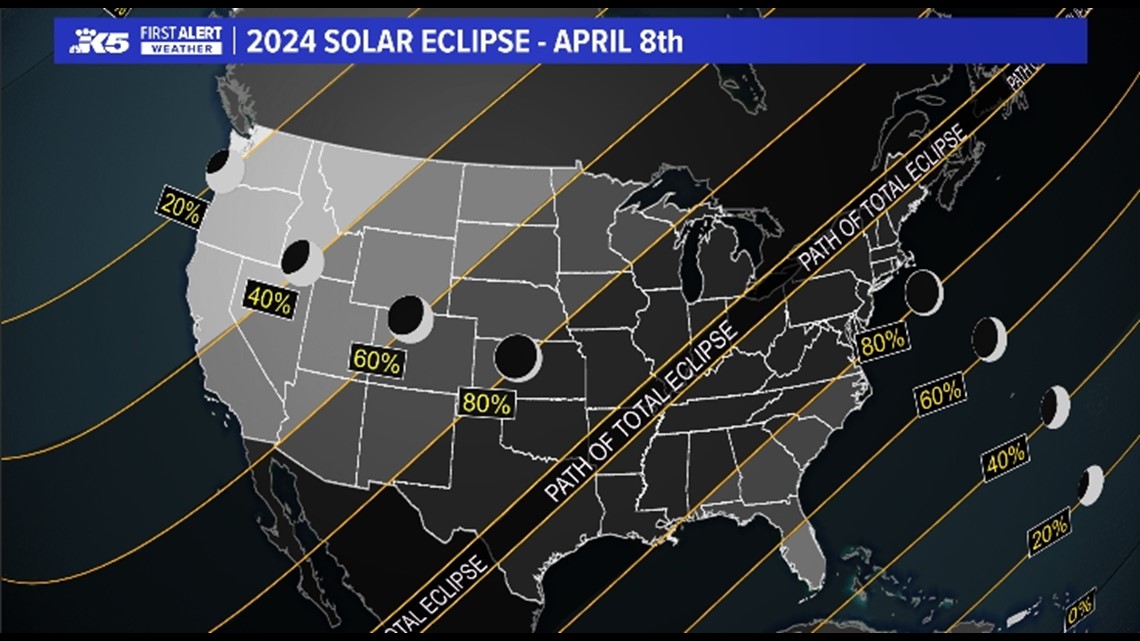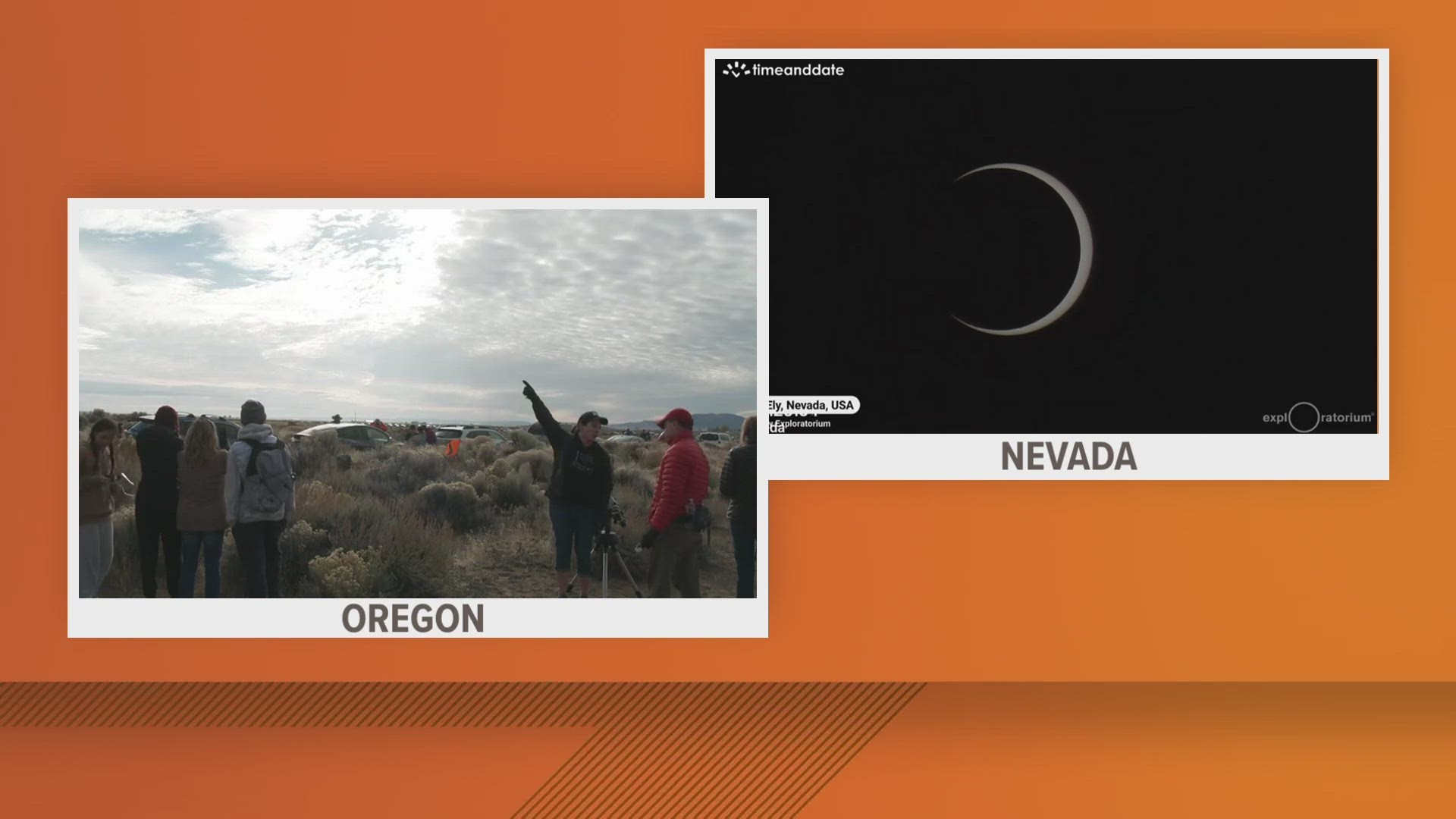SEATTLE — Millions of Americans will wake up Saturday morning to see a rare "ring of fire" solar eclipse.
The celestial event is a type of solar eclipse called an annular eclipse when the moon passes in front of the sun and creates the appearance of an illuminated ring in the sky. The National Aeronautics and Space Administration (NASA) said those in the path of annularity will be able to view a full "ring of fire" effect.
We won't get to see another annular eclipse here until 2046, but a full solar eclipse will occur over the central and eastern portions of the U.S. in April of 2024 .
When is the annular solar eclipse in Washington?
Patrick Koehn, NASA heliophysicist, said the eclipse will start around 8:10 a.m. PST in Washington. The eclipse will last about two hours in Washington.
The Northwest states will be among the first states in the country to see the eclipse, Koehn said.
When the eclipse begins and how long it'll last depends on where you are in reference to the path of annularity. For some, the eclipse could be as brief as 30 seconds or as long as five minutes.
“It’s an all-day event, just timed differently for different places in the world," Koehn said.


How much of the sun will be blocked in Washington?
Koehn said the sun will be about 81% blocked by the moon in Washington state.
“It will have the same shape as a new moon," Koehn said. "A skinny crescent shape of the sun.”
Regardless of location, however, Koehn said anyone in the United States should be able to see at least part of the eclipse on Saturday morning.
“Even if you don’t live within the eclipse path you can still see it," Koehn said. "It’s like a bite is being taken out of the sun like a bite is taken out of a cookie. No matter where you are in the contiguous states you’re going to be able to see this event.”
How to see the eclipse safely
With any solar eclipse, it's important to remember safety measures for your eyes.
Because the sun is never fully covered during an annular eclipse, it's not safe to directly look at the sun. Eclipse glasses, if you have any on hand, are recommended to protect your eyes. Koehn said you can pick up glasses at libraries and various locations. The frames for eclipse glasses are typically made out of paper, while the lenses are made using a special material, Koehn said.
“Under no circumstances should you take them off while viewing it," Koehn said. "You can cause some pretty serious damage to your eyes if you do."
Koehn said you can test your eclipse glasses for safety by holding them to a lightbulb If you can see the glow of the bulb, without any light from the room, the eclipse glasses are safe to use.
If you don't have eclipse glasses, Koehn said you can get a piece of paper, poke a hole through it and hold it over the sidewalk. This will create a "pinhole camera" that projects the image of the sun on whatever surface you're aiming at, Koehn said.
“We’re emphasizing safety because you really can wreck your eyes if you stare at the sun," Koehn said.
Here are alternative ways to watch the celestial event.
What's the weather forecast for Saturday?
As of Friday afternoon, this weekend's forecast is looking like it might not cooperate with the eclipse event.
Our latest forecast said it's trending toward being cloudy and a few showers. Most of the Pacific Northwest will be covered in clouds on Saturday morning.
Weather plays a factor in how much of the solar eclipse you'll be able to see. Although, even with a cloudy day, the daytime darkness that comes with solar eclipses will still be noticeable, NASA said.
Here is our latest forecast.
Are there any eclipse events in Washington?
NASA has a list of solar eclipse events across the country that you can see here.
“We’re trying to engage the public and not just going out and having the experience but also getting into the citizen science aspects and just observing the world around them," Koehn said.
The Pierce College Science Dome is having its solar eclipse event in Lakewood on Saturday morning. The organizers said it will have proper equipment to safely view the eclipse.
Solar viewing will be on the hill behind the college's Rainier building, according to the event. Organizers said admission into the dome will be on a first-come, first-served basis. The event will be happening rain or shine, but if the weather does not cooperate there will be a live stream of the eclipse from a sunny location inside the Rainier building.
It's not required to pre-reserve spots, but the event did ask for RSVPs for planning purposes.
You can keep up with more information on NASA Sun's Twitter page as well.
What states will see the 'ring of fire' solar eclipse 2023?
The annular solar eclipse's path will pass through much of the western and southwestern U.S., including major U.S. cities like Eugene, Oregon, Albuquerque, New Mexico and San Antonio, Texas.
While those outside the path of annularity might not get to see the rare "ring of fire," many will be able to witness the moon partially block the sun.
“This is one of those things that you don’t get to see very often," Koehn said. "I can count on one hand the number of times ’I've heard about eclipses going on. Usually, it’s over the ocean so you don’t get to see them. If you can get out and actually witness this you’re watching a celestial event at the same time as millions of other people all looking at the same spot in the sky. The temperature goes down, the lighting goes down, the sound changes, the air changes – it’s an experience. We’re trying to get people to get out and experience the universe.”
For more information on the specific cities that are in the path of annularity, visit NASA's Where and When page.
When was the last 'ring of fire' solar eclipse?
The last time the U.S. saw an annular eclipse was in May 2012.
What is a 'ring of fire' solar eclipse?
During Saturday's solar eclipse, the moon and the sun will create the effect of a "ring of fire."
According to NASA, annular solar eclipses occur when the moon passes between the Earth while still being at its farthest point away from Earth. The moon, being farther away from us, appears smaller than the sun and does not fully cover it, resulting in the "ring of fire" illusion.
“You get this ring around the outside (of the sun)," Koehn said. "It’s really a phenomenal event. We call that the ‘ring of fire.’”
The word annular is derived from the Latin word "annulus" which means ring, according to TimeandDate.com
Those in the path of annularity will have as much as 90% of the sun blocked by the moon. As a result, people can feel a slight change in temperature and there will be a dimness in daylight much like during a sunset or sunrise, according to NASA.
Koehn said birds will start roosting and animals will think it is time for bed during an eclipse event.
"The experience itself is pretty singular," Koehn said. "It’s not something you see every day. But from a science perspective when the sun is no longer dumping all of its energy into the atmosphere the ionosphere changes. It’s a high-altitude layer of charged particles in the atmosphere. So when the sun goes away, whether at night or during an eclipse, all of a sudden that ionosphere starts to fade. So you get all sorts of interesting radio propagation effects.”
Koehn said eclipses happen regularly but most of the time they happen over water and not over areas with a high population.
When is the next eclipse?


A total solar eclipse happens when the Moon passes between the Sun and Earth, completely blocking the face of the Sun, according to NASA. The sky will darken as if it were dawn or dusk.
Koehn said it is very unusual for two solar eclipses to happen back-to-back over highly populated areas.

